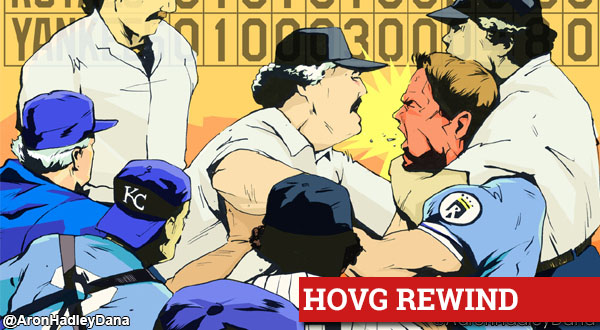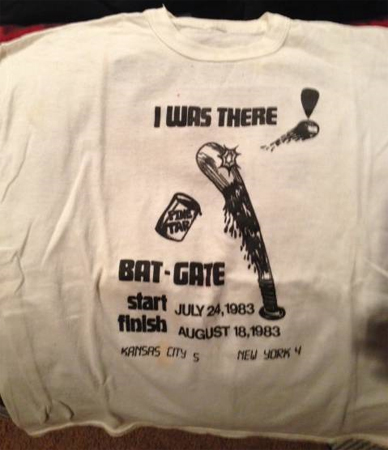![]()
In 1955, team owners were in a bind…they were losing too much money on baseballs that were stained and smudged with the pine tar being used on bats.
To combat that loss, baseball implemented a rule…MLB Rule 1.10(c). It was a simple one really. Basically, you can treat your bat with anything to help “improve the grip”. But here’s the catch. That material cannot extend past 18 inches. If it does…the hit is deemed “illegal” and the batter called out.
On July 24, 1983 the “Pine Tar Rule” received national attention when Kansas City Royals great George Brett hit a go ahead two-run home run off New York Yankees closer Goose Gossage.
And then…mayhem.
Three guys that witnessed the madness up close were Brett’s Royals teammates…Don Slaught, Leon Roberts and Greg Pryor.
HOVG: From your perspective…what happened?
SLAUGHT: We enter the top of the ninth down by one run. Goose Gossage on the mound for the Yankees and George Brett coming to the plate. Premiere stopper versus premiere hitter in the league. But there is history between the two. In 1980, Game 3 (of the ALCS) George hit a home run off Gossage to sweep Yankees. Can he do it again?
ROBERTS: Billy Martin was looking for a chance to get Brett if he got an important hit…it started in KC the week before. And sure enough, he hits a clutch homer off Goose. What was crazy was a bunch of things. How do they measure the pine tar? If (we’re) in KC, do they call him out?
PRYOR: For the only time in my career, I was in the bullpen since both of our catchers (Don Slaught and Jon Wathan) were in the game. We saw the ball go off, it went way out…I think to the upper deck. We then saw the meeting at homeplate. I knew what was going on because it got called on me in A ball. So when I saw the meeting…it was obvious they were protesting.
HOVG: How crazy was the aftermath?
SLAUGHT: After the celebration of the home run, George takes a seat on the bench. As Billy Martin walks out to home plate, someone starts to explain to George what Billy was doing. George’s response…“if he calls me out, I’ll kill him”. Just seconds after the comment, Tim McClellan, the umpire, calls him out and the rest of the team is trying to catch up to George because we believed (he’d kill him). Some players were trying to get between George and umpire and others were trying to get possession of the bat.
ROBERTS: Gaylord (Perry) grabbed the bat and tried to run up the tunnel to hide the evidence! (What followed) was crazy. We had to wait for a ruling of the protest from the American League president. (We) sat on the airport runway for two hours waiting for a ruling from a judge.
PRYOR: I saw George’s explosion from the bullpen and I saw Gaylord Perry and Rocky Colavito running away with the bat. They were intercepted by the police.
SLAUGHT: When the game was resumed, I was the most nervous of any game I played. We were at Yankee Stadium, with all the media of an All-Star Game and no fans in the stands. We went through preparing for the game and then it was over in just minutes. Don Mattingly playing second…Ron Guidry in the outfield. Dan Quisenberry was on the mound.
PRYOR: After the game, I’m taking the long walk into the clubhouse and since my locker was next to George, I wore number 4, he wore 5, and I couldn’t see it. There were dozens, maybe 50 people in front of our lockers. So I went across the clubhouse and waited, waited and waited. When the reporters were gone, I asked George “what’s wrong with you?” He says “I lost the homerun, we lost the game.” “Listen,” I told him, “some company is going to give you 150 grand to endorse their pine tar.” George was really excited. So I guess I helped lighten the tension.
“I was taking (Gaylord) Perry’s picture during batting practice at Fenway Park and we were chatting. I said it would be great to get a picture of you and (George) Brett with the bat. Perry got Brett, they went into the dugout and we took the picture.” – Former Fleer photographer Steve Babineau
HOVG: At the time, MLB Rule 1.10(c) stated: “The bat handle, for not more than 18 inches from the end, may be covered or treated with any material or substance to improve the grip. Any such material or substance, which extends past the 18-inch limitation, shall cause the bat to be removed from the game.” At the time, such a hit was defined in the rules as an illegally batted ball, and the penalty for hitting “an illegally batted ball” was that the batter was to be declared out, under the explicit terms of the then-existing provisions of Rule 6.06. Were you aware of Rule 1.10(c)?
ROBERTS: In baseball? Yes, most hitters are aware of the rule. But, there have been a lot of bats that are doctored.
SLAUGHT: As defined by the rules at time, the umpire ruled it correctly.
HOVG: It’s been 30 years, is the game an afterthought at this point? Does it still get brought up?!?
SLAUGHT: It is brought up all the time…mostly because of how many times it has re-played on ESPN Classic.
ROBERTS: Yes, I hear about all the time.
HOVG: Lastly, did baseball get it right?
PRYOR: In retrospect, what they should have done was finish the game, then let (American League president) Lee MacPhail hear the appeals and make the decision. We should have never had to go back to New York to finish the game.
SLAUGHT: Yes. I believe Lee MacPhail got it correct by determining that the pine tar on the bat had nothing to do with the home run.
ROBERTS: The protest was done right. Pine tar does not help in any way.
PRYOR: When the decision was overturned, we had to fly back to New York. I took over at third base for George. I’ve been in a number of odd situations, but how do you get ready for a situation like that? George actually stayed back in New Jersey and never came to the game. When we got back on the plane after the game, George was waving a wad of cash and smacking guys in the cheek with it. “I just sold the pine tar bat,” he tells us. At the time, I was pretty sure that he said he sold it for 15 (grand), but it’s turned into 25 (grand) over the years. (Laughs)
 “Pine Tar Game” t-shirt, created and distributed to team by Gaylord Perry. Courtesy: Greg Pryor.
“Pine Tar Game” t-shirt, created and distributed to team by Gaylord Perry. Courtesy: Greg Pryor.
ABOUT DON SLAUGHT
Don Slaught was the starting catcher for the Kansas City Royals on July 24, 1983. He went 3-for-4 with a triple and an RBI. He played for seven teams during his 16-year big league career. Slaught is currently the owner of RightView Pro…a training aid for young baseball and softball players.
ABOUT LEON ROBERTS
Leon Roberts was the starting leftfielder for the Kansas City Royals on July 24, 1983. He went 2-for-3. He played for six teams during his 11-year big league career.
ABOUT GREG PRYOR
Greg Pryor took over for George Brett at third base when the game resumed August 18. He played three teams during his ten-year big league career. Pryor currently hosts a radio show in Kansas City and runs Life Priority.
Add The Sports Daily to your Google News Feed!


